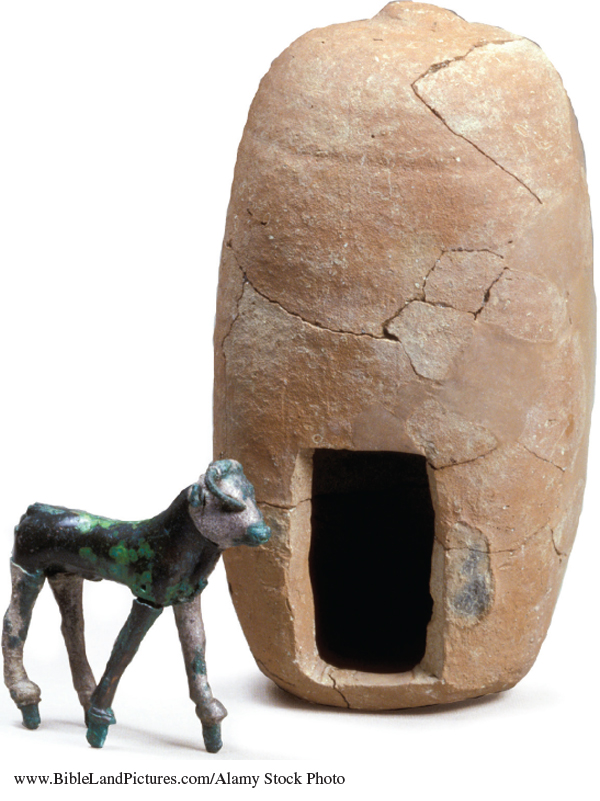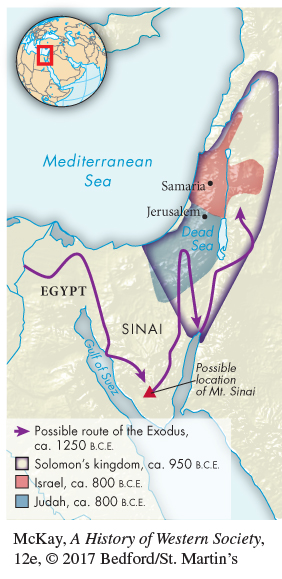The Hebrew State
40
Most of the information about the Hebrews comes from the Bible, which, like all ancient documents, must be used with care as a historical source. Archaeological evidence has supported many of its details, and because it records a living religious tradition, extensive textual and physical research into everything it records continues, with enormous controversies among scholars about how to interpret findings.
The Hebrews were nomadic pastoralists who may have migrated into the Nile Delta from the east, seeking good land for their herds of sheep and goats. According to the Hebrew Bible, they were enslaved by the Egyptians, but were led out of Egypt by a charismatic leader named Moses. The biblical account is very dramatic, and the events form a pivotal episode in the history of the Hebrews and the later religious practices of Judaism. Moses conveyed God’s warning to the pharaoh that a series of plagues would strike Egypt, the last of which was the threat that all firstborn sons in Egypt would be killed. He instructed the Hebrews to prepare a hasty meal of a sacrificed lamb eaten with unleavened bread. The blood of the lamb was painted over the doors of Hebrew houses. At midnight Yahweh spread death over the land, but he passed over the Hebrew houses with the blood-
According to scripture, the Hebrews settled in the area between the Mediterranean and the Jordan River known as Canaan. They were organized into tribes, each tribe consisting of numerous families who thought of themselves as all related to one another and having a common ancestor. At first, good farmland, pastureland, and freshwater sources were held in common by each tribe. Common use of land was — and still is — characteristic of nomadic peoples. The Bible divides up the Hebrews at this point into twelve tribes, each named according to an ancestor.
In Canaan, the nomadic Hebrews encountered a variety of other peoples, whom they both learned from and fought. They slowly adopted agriculture, and not surprisingly, at times worshipped the agricultural gods of their neighbors, including Baal, an ancient fertility god represented as a golden calf. This was another example of the common historical pattern of newcomers adapting themselves to the culture of an older, well-

The Bible reports that the greatest danger to the Hebrews came from a group known as the Philistines, who were most likely Greek-
41
The Bible includes detailed discussion of the growth of the Hebrew kingdom. It relates that Saul’s work was carried on by David of Bethlehem (r. ca. 1005–965 B.C.E.), who pushed back the Philistines and waged war against his other neighbors. To give his kingdom a capital, he captured the city of Jerusalem, which he enlarged, fortified, and made the religious and political center of his realm. David’s military successes enlarged the kingdom and won the Hebrews unprecedented security, and his forty-
David’s son Solomon (r. ca. 965–925 B.C.E.) launched a building program that the biblical narrative describes as including cities, palaces, fortresses, and roads. The most symbolic of these projects was the Temple of Jerusalem, which became the home of the Ark of the Covenant, the chest that contained the holiest of Hebrew religious articles. The temple in Jerusalem was intended to be the religious heart of the kingdom, a symbol of Hebrew unity and Yahweh’s approval of the kingdom built by Saul, David, and Solomon.

Evidence of this united kingdom may have come to light in August 1993 when an Israeli archaeologist found an inscribed stone slab that refers to a “king of Israel,” and also to the “House of David.” This discovery has been regarded by most scholars as the first mention of King David’s dynasty outside of the Bible. The nature and extent of this kingdom continue to be disputed among archaeologists, who offer divergent datings and interpretations for the finds that are continuously brought to light.
Along with discussing expansion and success, the Bible also notes problems. Solomon’s efforts were hampered by strife. The financial demands of his building program drained the resources of his people, and his use of forced labor for building projects further fanned popular resentment.
A united Hebrew kingdom did not last long. At Solomon’s death his kingdom broke into political halves. The northern part became Israel, with its capital at Samaria, and the southern half became Judah, with Jerusalem remaining its center. War soon broke out between them, as recorded in the Bible, and the Assyrians wiped out the northern kingdom of Israel in 722 B.C.E. Judah survived numerous calamities until the Babylonians crushed it in 587 B.C.E. The survivors were forcibly relocated to Babylonia, a period commonly known as the Babylonian Captivity. In 539 B.C.E. the Persian king Cyrus the Great (see “Individuals in Society: Cyrus the Great.”) conquered the Babylonians and permitted some forty thousand exiles to return to Jerusalem. They rebuilt the temple, although politically the area was simply part of the Persian Empire.